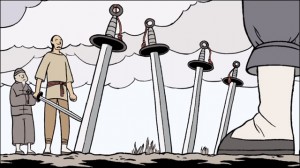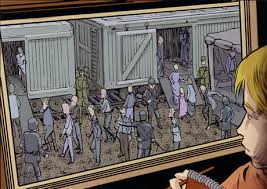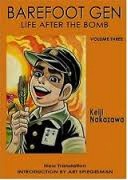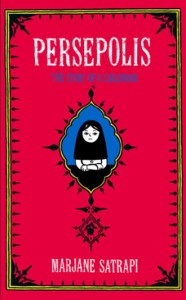 |
| Gene Luen Yang, Boxers and Saints (First Second) |
In honor of
ABCWednesday's "K" week, I thought I'd share some of my favorite comics and graphic novels that teach kids (of all ages) about the consequences (and often the horrors) of war.
Comics, and graphic novels in particular, have come a long way over the
last few years. They are exquisitely written and drawn and the number of school and curriculum-appropriate books continues to expand. While engaging and empowering all levels of readers, the images make it easier for readers in relate to and incorporate their content. This makes them powerful classroom non-fiction tools - especially when teaching, relaying and depicting the devastating affects of war.
Here are a few of my favorite graphic novels for kids, that relay the truths, the horrors, and the consequences of war - all for middle grade readers and older. [Note some have links for greater discussion or exploration.]:
- Barefoot Gen by Keiji Nakazawa, translated by Project Gen (Last Gasp of San Francisco, 2004 - ages 12+), chronicles the aftermath
of the Pacific War. Barefoot Gen is an important work and classroom addition. It's considered one of the most important anti-war manga ever written. First,
it relays an informed accounting of Japan’s role in World War II and is a
strong anti-war piece that cannot and should not be silenced. Second,
Nakazawa relates a strong geopolitical perspective of the war,
discussing the power of political machines, “divine rule” versus
democracy, and the power individual citizens must exercise to secure
their rights and uphold their values. Finally, this work provides a
window for understanding and comparing Eastern and Western cultures —
where they meet, where they clash, and what we can and cannot assume.
- Boxers and Saints (First Second - ages 10+) by Gene Yang - National
Book Award finalist and two-book set that recounts the Boxer Rebellion
(1900) from both sides - that of the Boxers (Chinese peasants who
believed they could invoke ancient Chinese Gods/heroes to help them
battle Western Imperialism and the Chinese Catholics they converted) and
the Saints (the Chinese converts who wanted to bring peace to war-torn
China.
- Dogs of War (Scholastic - ages 9+) by Sheila Keenan and Nathan Fox, consists of three
different stories set in three different wars: World War I,
World War II, and the Vietnam War. While the stories are fiction,
they've been meticulously researched and relayed in rich
detail. Each vignette relates the trails and traumas,and dangers the
dogs, their handler and fellow soldiers risk in battle, and the tolls
the wars took on all concerned.
 |
| Sheela Keenen and Nathan Fox (Scholastic) |
 |
| Boaz Yakin and Nick Bertozzi (First Second) |
- Jerusalem by Boaz Yakin and Nick Bertozzi (Ages 12+) - about the personal and
political issues and decisions various members of a Jerusalem family
must face in war-torn Jerusalem 1940-48. The story begins with the British Mandate giving way to a United Nations
Partition Plan that then gives way to civil conflicts and the
Arab-Israeli War of 1948. It follows Yakin's family's history while
following the history of Jerusalem as its characters wrestle with
ideals, faith and hopes.
- Marathon by Boaz Yakin and Joe Infurnari (First Second Books, Grades 6+) tells
the story of Eucles and The Battle of Marathon. Eucles, an Athenian
messenger in the year 49 ran over 300 miles to save Ancient Greece from
being subjugated into the Persian Empire. The Battle of Marathon was the
turning point in ancient history, and the foundation of the modern
Olympic games.
 |
| From Marathon Boaz Yakin and Joe Infurnari (First Second) |
 |
| Art Spiegelman (Pantheon) |
- Maus by Art Spiegelman is a retelling of his parents' Holocaust experience which Spiegelman tells through conversations with his father. The Nazi's are depicted as cats, and their victims as mice. This cartooning approach makes the story more accessible and somewhat less threatening, empowering readers to more comfortably explore the realities, fears and guilt the holocaust raises. Maus has won many awards, including the Pulitzer Prize in 1992 (recommended for mature middle school readers and older).
- Persepolis by Marjane Satrapi (ages 10+) is the story of Marjane Satrapi’s childhood and coming of age within a
loving, educated family that lived in Tehran during the Islamic
Revolution and Iran-Iraq War. It is drawn in simple, stark, black and
white ink with style, poignancy, and elegant detail as well as
occasional flourishes (usually in the dream sequences) traditionally
found in Eastern art.
 |
| Jablonski and Purvis (First Second) |
- Resistance Trilogy (First Second - ages 9+) by Carla Jablonski and Leland Purvis - a graphic novel
trilogy is about life in occupied France during World War II. The main
characters must decide whether to collaborate with the Germans (to gain
'favors') or delay gratification and face rationing of supplies as well
as struggle through the war without knowing whether their father has
survived. This trilogy is a wonderful (historical) fiction story that accurately relates
life in France in the late 1930's to early 1940's.
- Rust (ongoing series, Archaia) by Royden Lepp (Ages 9+) Rust, brilliantly
illustrated in sepia tone (giving the story a Dust Bowl and post
World War I feeling) is all about life after a horrific war fought by men and robots. The land, the people and their families have been devastated. With flashbacks from the war, the three volumes (there's a fourth on in the works) chronicle one robot and a family who harbors him. For more, please read this Review of Rust detailing each book and containing teaching and book group discussion suggestions.
 |
| Royden Lepp (Archaia) |
- Zahra's Paradise (ages 12+) is a webcomic and graphic novel by Amir with illustrations by Khalil
(both have chosen to remain anonymous for political reasons), published
in 2011 and published by First Second Books. Its story takes place in Iran, June 2009 after one of the great street
protests following the elections. And, while it
is a story about human rights and the turmoil of a troubling time, it
also about the love of a people who help this mother through her
heartbreaking ordeal.
 |
| Amir & Khalil (First Second Books) |
These are some of my favorites.
As always, thank you for your visit.
Please leave your favorites, or your opinion about these books in the comments below.









Not really my type of reading, but I sure know who I am going to tell.
ReplyDeleteHave a nice day!
I would add Grave of the Firefly but its a anime movie but also about war. Love Graphic Novels but havent read any of this yet. I wonder if these are available in our library.
ReplyDeleteMost of them should be, particularly Maus and Perseoplis. If not, ask, I'm sure they'll be able to get them from other ancillary libraries. Thanks for the comment.
DeleteHi Meryl! I always ask myself: who starts a war and why? Wars are so useless. Nobody wins.
ReplyDeleteThanks for your ideas and for this post.
Wil, ABCW
MANY years ago, before Maus, I used y chat with Art Spiegelman, He was working on this oversize art mag called RAW. Interesting duded.
ReplyDeleteROG, ABCW
I know RAW. Wow, now I'm really jealous... great Kelloggs cereal bowls AND conversations with Spiegelman. You are very cool!
DeleteI love graphic novels, they are a ton of fun to read!
ReplyDeletehttps://saglamproxy.com
ReplyDeletemetin2 proxy
proxy satın al
knight online proxy
mobil proxy satın al
SOQ